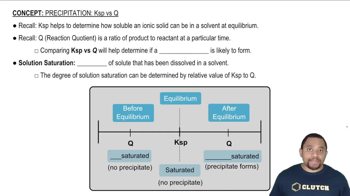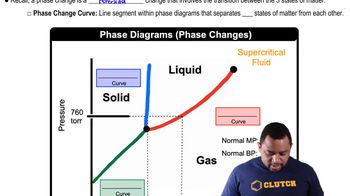The diagram shown here represents the equilibrium state for the reaction A2(𝑔) + 2B(𝑔) ⇌ 2AB(𝑔). (a) Assuming the volume is 2 L, calculate the equilibrium constant 𝐾𝑐 for the reaction.
Write the expression for 𝐾𝑐 for the following reactions. In each case indicate whether the reaction is homogeneous or heterogeneous.
(e) 2Ag(𝑠) + Zn2+(𝑎𝑞) ⇌ 2 Ag+(𝑎𝑞) + Zn(𝑠)
 Verified step by step guidance
Verified step by step guidance
Verified Solution
Key Concepts
Equilibrium Constant (Kc)

Homogeneous vs. Heterogeneous Reactions

Phase Representation in Reactions

Suppose that the gas-phase reactions A → B and B → A are both elementary reactions with rate constants of 4.7×10−3 s−1 and 5.8×10−1 s−1, respectively. (b) Which is greater at equilibrium, the partial pressure of A or the partial pressure of B?
The equilibrium constant for the dissociation of molecular iodine, I2(𝑔) ⇌ 2 I(𝑔), at 800 K is 𝐾𝑐 = 3.1×10−5. (b) Assuming both forward and reverse reactions are elementary reactions, which reaction has the larger rate constant, the forward or the reverse reaction?
Write the expressions for 𝐾𝑐 for the following reactions. In each case indicate whether the reaction is homogeneous or heterogeneous.
(b) Ti(𝑠) + 2Cl2(𝑔) ⇌ TiCl4(𝑙)
Write the expressions for 𝐾𝑐 for the following reactions. In each case indicate whether the reaction is homogeneous or heterogeneous. (g) 2 C8H18(𝑙) + 25 O2(𝑔) ⇌ 16 CO2(𝑔) + 18 H2O(𝑙)
Which of the following reactions lies to the right, favoring the formation of products, and which lies to the left, favoring the formation of reactants? (b) 2 HBr(𝑔) ⇌ H2(𝑔) + Br2(𝑔) 𝐾𝑐 = 5.8×10−18
